



William T. Betz, DO, MBA Senior Associate Dean for Osteopathic Medical Education
1994: We will have a medical crisis 2001: We will have a medical crisis 2010: We have a medical crisis 2014: We are really having a medical crisis
Decreased access - existent problem in Rural America Increased utilization ( ACA) Increased utilization (Baby boomers) Increased physician retirement Increased physician movement from direct patient care Decreased reimbursement Long work hours – work balance Increased direct cost in medical education (student loans - $300k) Etc.
2010: ACA funding for 550 residents in underserved rural and urban areas Incentives and investments to boost family medicine are scheduled to end this year and next year Need to create residencies in area of need - a great predictor as to where they practice Most residencies in large metro areas in a multi-specialty program
34% of US doctors practice primary and family care Research shows a ration closer to 50:50 would provide better care and improved health overall Rural programs with associated healthcare partners to share the workload (ARNPs and PAs)
First class – 1997 ◦ 60 students First graduation class – 2001 Class of 2018 ◦ 135 students ◦ GPA Cumulative – 3.5 ◦ MCAT Cumulative – 24.6 ◦ 28 states KY 51% ◦ Gender Female – 30% Male – 70%
Primary Care – 75% ◦ Family Medicine – 33% ◦ Internal Medicine – 21% ◦ Pediatrics – 6% ◦ Traditional Rotating Internship – 15% Specialty Care – 25% ◦ Anesthesiology – 3% ◦ Emergency Medicine – 7% ◦ General Surgery – 4% ◦ Neurology – 1% ◦ Obstetrics & Gynecology – 6% ◦ Orthopedic Surgery – 1.4% ◦ Physical Medicine & Rehabilitation – 2.8%
2 nd Year Clinical experience ◦ Regional physicians Primary care emphasis Afternoon exposure
3 rd & ◦ Diffuse clinical sites Core curriculum 4 th Year ◦ Diffuse clinical sites Selective rotations Elective rotations
Pikeville site Morehead site Ashland site Northern Kentucky site Bowling Green site Owensboro site Hazard site Purchase site Henderson site Somerset site Lincoln Trail site
Alabama Arkansas Indiana Michigan Mississippi Ohio
Family Medicine ◦ Two 4-week blocks Internal Medicine ◦ Two 4-week blocks Pediatrics ◦ Two 4-week blocks General Surgery ◦ Two 4-week blocks Women’s Health ◦ One 4-week block Psychiatry ◦ One 4-week block
Emergency Medicine ◦ One 4-week block Osteopathic Principles & Practice ◦ One 4-week block Internal Medicine subspecialty ◦ One 4-week block Rural Medicine (AHEC, site assigned) ◦ One 4-week block Women’s Health ◦ One 4-week block
Approval by the associate dean for clinical affairs Location, specialty, physician are chosen by student 16 weeks clinical experience ◦ 2-week blocks ◦ 4-week blocks ◦ Up to 8 weeks in clinical research time
Clinical Rotations ◦ Obstetrics & Gynecology ◦ Pediatrics ◦ Psychiatry Faculty Development Rural Mentorship/Residencies ◦ Rural experience ◦ Urban collaboration for subspecialty training Rural Financial Reimbursements ◦ Improved primary care funding ◦ Need for education debt reduction for rural care
We can look at what we have accomplished We must look to the future of education The ways of student training need to increase student exposure to the most important aspect of their training… …The Patient Collaboration in medical education will help meet the needs of Kentucky Healthcare
Recommend
More recommend